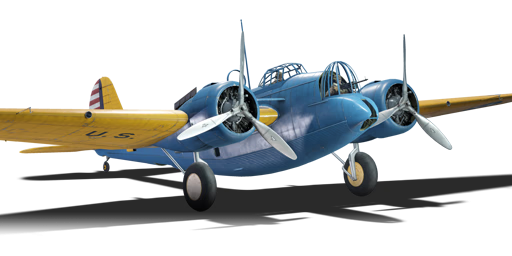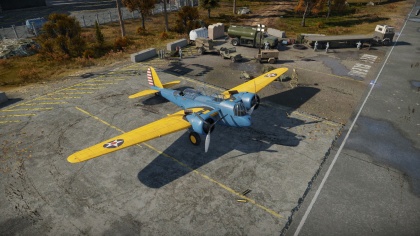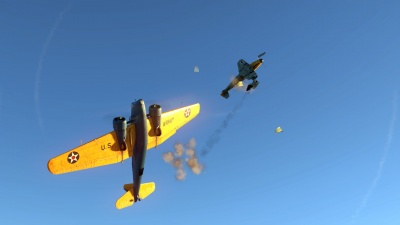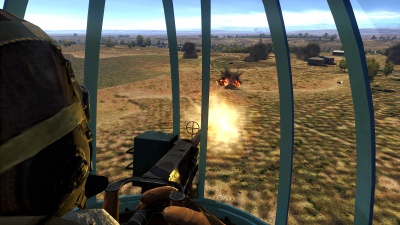B-10B
Contents
| This page is about the American bomber B-10B. For other version, see Martin 139WC. |
Description
The B-10B is a premium rank I American bomber
with a battle rating of 1.3 (AB/RB) and 1.7 (SB). It was introduced in Update 1.67 "Assault".
General info
Flight performance
The B-10B might come across as fairly mediocre, it accelerates fairly slowly, doesn't have WEP in RB and SB modes, and cruises at altitude at around 280 km/h, which is faster than several contemporary bombers, but isn't overly impressive. However, it is incredibly manoeuvrable for a bomber, it can out-turn most Axis monoplane fighters excluding the Japanese, and can safely deploy flaps for most defensive manoeuvres, and turns very well horizontally but not so much vertically. It, of course, can't out turn biplanes, but can outrun most of them in a shallow dive.
Its primary bomb loads, the single 2,000 lb bomb or the two 1,000 lb bombs, do create a fair amount of drag as they're carried externally, however, the B-10 is fast enough to reach bombing points before having to engage with enemy fighters, so the extra drag generally won't be particularly noticeable.
| Characteristics | |||||||
|---|---|---|---|---|---|---|---|
| Stock | |||||||
| Max Speed (km/h at 2,438 m) |
Max altitude (meters) |
Turn time (seconds) |
Rate of climb (meters/second) |
Take-off run (meters) | |||
| AB | RB | AB | RB | AB | RB | ||
| 331 | 319 | 7380 | 21.8 | 22.7 | 6.3 | 6.2 | 600 |
| Upgraded | |||||||
| Max Speed (km/h at 2,438 m) |
Max altitude (meters) |
Turn time (seconds) |
Rate of climb (meters/second) |
Take-off run (meters) | |||
| AB | RB | AB | RB | AB | RB | ||
| 355 | 343 | 7380 | 20.2 | 21.0 | 9.3 | 7.7 | 600 |
Details
| Features | ||||
|---|---|---|---|---|
| Combat flaps | Take-off flaps | Landing flaps | Air brakes | Arrestor gear |
| ✓ | ✓ | ✓ | X | X |
| Limits | ||||
|---|---|---|---|---|
| Wing-break speed (km/h) |
Gear limit (km/h) |
Combat flaps (km/h) |
Max Static G | |
| + | - | |||
| 340 | ~6 | ~3 | ||
| Optimal velocities | |||
|---|---|---|---|
| Ailerons (km/h) |
Rudder (km/h) |
Elevators (km/h) |
Radiator (km/h) |
| < 200 | < 270 | < 290 | > 307 |
| Compressor (RB/SB) | ||
|---|---|---|
| Setting 1 | ||
| Optimal altitude | 100% Engine power | WEP Engine power |
| 2,200 m | 760 hp | N/A |
Survivability and armour
The B-10B lacks any armour protection, but it is surprisingly durable, not only because it most often fights aircraft only armed with machine guns, but also because most of the wing area is empty of any fuel tanks. The fuel tanks are located between the engines and the fuselage which is an area rarely hit. The B-10 also can run on one engine but only if other areas aren't too heavily damaged: being a generally large and slow aircraft it suffers from drag caused by structural damage substantially, meaning it can destabilise and fall out of the sky if an engine is damaged as well.
The tail is the most vulnerable area, there's a lot of control surfaces present in the rear of the aircraft, and the elevators are very large targets, machine guns will shred through these areas even if given only a short time on target.
The crew additionally are fairly vulnerable, the pilot notably is very exposed, being positioned quite high up on the fuselage, the tail gunner as well catches a lot of fire, but due to the B-10's manoeuvrability, the crew become very hard targets to hit while the aircraft is flying defensively.
Armaments
Suspended armament
The B-10B can be outfitted with the following ordnance:
- 6 x 250 lb AN-M57 bombs (1,500 lb total)
- 2 x 500 lb AN-M64A1 bombs (1,000 lb total)
- 2 x 1,000 lb AN-M65A1 bombs (2,000 lb total)
- 1 x 2,000 lb AN-M66A2 bomb (2,000 lb total)
Defensive armament
The B-10B is defended by:
- 1 x 7.62 mm Browning machine gun, nose turret (600 rpg)
- 1 x 7.62 mm Browning machine gun, dorsal turret (600 rpg)
- 1 x 7.62 mm Browning machine gun, ventral turret (600 rpg)
Usage in battles
As a bomber, the B-10B does the job well. It can easily reach bombing points before interception and can level a base with a single 2,000 lb bomb, and can then turn away and return to base to rearm. If enemy fighters are at altitude, consider using clouds for cover, or entering a shallow dive towards friendly fighters, or the airfield.
This aircraft works very well defensively and can be very effective when flown with a squadmate. As the B-10 is very manoeuvrable, it can out-turn most enemy fighters, but lacks the firepower to deal with them effectively, it has no fixed guns and is only equipped with .30 calibre machine guns, and controlling them manually in a dogfight isn't really a viable option. But when playing with a friend, the B-10 can engage a fighter, and while manoeuvring, can draw the enemy into a low energy state, making it a very easy target to take out.
On your own, you can still comfortably dogfight one-on-one with most German and Italian monoplane aircraft, but if this fight is away from friendlies, another enemy fighter could engage with you, and being such a large target, a 2-on-1 fight likely won't go in your favour. As you are a big target, and with two enemies around you, one is likely going to take out a critical component sooner or later.
Try diving towards friendlies before engaging in a dogfight, the closer you are to your allies, the more likely it is that they'll come to your aid, the further away you are, the more likely it is that an enemy will join the fight instead.
If there are no enemies around later on in the match you can attack light ground targets by manually controlling your nose gunner, just make sure to watch out for any trees or ground hazards as there will be a delay before you can switch back to direct control of the aircraft.
The B-10B also works well in combined tank battles, as the 2,000 lb bomb will be more than enough to take out several tanks in close proximity as most vehicles will be very lightly armoured. It is slow and a large target, but as most anti-air is fairly weak around its battle rating, it should survive a bombing run.
Manual Engine Control
| MEC elements | ||||||
|---|---|---|---|---|---|---|
| Mixer | Pitch | Radiator | Supercharger | Turbocharger | ||
| Oil | Water | Type | ||||
| Controllable | Controllable Not auto controlled |
Controllable Not auto controlled |
Controllable Not auto controlled |
Separate | Not controllable 1 gear |
Not controllable |
Modules
| Tier | Flight performance | Survivability | Weaponry | ||
|---|---|---|---|---|---|
| I | Fuselage repair | Radiator | Turret 7 mm | SBC-17 | |
| II | Compressor | Airframe | New 7 mm MGs (turret) | ||
| III | Wings repair | Engine | MBC-17 | ||
| IV | Cover | LBC-17 | |||
- Being a premium aircraft, it has all its modules researched by default.
Pros and cons
Pros:
- Very manoeuvrable for a bomber
- The bombload is more than capable of leveling bases and vehicle formations. A single 2,000 lb bomb can net you 850+ points in a match from a good run
- The frontal gunner, while only having a .30 cal, can be used as a manual weapon if you keep the front of the plane on an enemies tail, or for attacking ground targets
- As it's a less well-known aircraft, enemies may not know how to effectively fight it
- It can easily take fire from machine guns on the wings, and in general is fairly survivable
- While having limited fire arcs on the rear turrets, they cover a wide area and can surprise enemies that don't know they're there
- The 2,000 lb bomb works well in ground forces
Cons:
- It's a large target, and even though the critical components are hard to hit individually, the large wings and tail will accumulate damage over time
- Despite its comparatively good speed, most Axis and Russian aircraft can catch up to it easily
- Unlike its younger brother, the B-18A, the B-10's rear gunners have a slightly restricted field of view over the tail, where the gunners can't fire
History
The B-10 started out as a private venture by Glenn L. Martin Company in 1932 as the Martin Model 123. It had a number of features that were revolutionary at the time. These included an internal bomb bay, retractable landing gear, and rotating gun turrets. The model 123 did not have fully enclosed crew stations; there were 4 crewmembers. The Model 123 was delivered to the Army for testing in March of 1932, and was designated as the XB-907. It was sent back to Martin for redesigning and was designated as the XB-10. It differed from the Model 123 in that it had a full engine cowling, larger wingspan, fully enclosed crew stations, and a reduction in crew to 3. The Army ordered 48 in 1933, and the first 14 were designated as YB-10, and served as mail carriers for the Army Air Corps Mail Operation.
The Army ordered an addition 103 aircraft in 1935, which were called the B-10B. These had a more powerful engine. In February 1936, the B-10B's dropped food and supplies to Tangier Island in Virginia and Smith Island in Maryland. The Chesapeake Bay was frozen over by a winter storm, and the only way to get supplies to the islands was by air. Otherwise, the islanders would have starved. In 1936, the last of the Army's orders had been completed, and Martin was given permission to export the B-10. The B-10 was exported to Argentina, China, The Netherlands, The Philippines, Siam (Thailand), Turkey, and the Soviet Union. Notably, Chinese B-10's were used to drop leaflets on Japan during the Sino-Japanese War. Dutch B-10's also fought in the Dutch East Indies against Japan.
The B-10 was a huge advance in technology. It was so advanced at the time, that it made all pre-existing bomber designs obsolete. The B-10 set the trend for bomber designs in the years to come. By the time World War 2 was initiated, the B-10 itself had become obsolete, and was replaced by more capable designs, such as the B-18 and B-17.
Media
Excellent additions to the article would be video guides, screenshots from the game, and photos.
See also
- Aircraft of comparable role, configuration and era
External links
Paste links to sources and external resources, such as:
- topic on the official game forum;
- encyclopedia page on the aircraft;
- other literature.
| Glenn L. Martin Company | |
|---|---|
| Attackers | AM-1 |
| Bombers | B-10B · B-26B · PBM-1 · PBM-3 · PBM-5A |
| Jet bombers | B-57A* · B-57B* |
| Export | Martin 139WC · Martin 167-A3 · B-26C |
| * These aircraft were license-built from The English Electric Company Limited who developed and built the British English Electric Canberra. | |
| USA bombers | |
|---|---|
| Dive | SB2U-2 · SB2U-3 · SBD-3 · SB2C-1C · SB2C-4 |
| Torpedo | TBD-1 · PBY-5 Catalina · PBY-5A Catalina · TBF-1C · BTD-1 |
| Medium | B-10B · B-18A · B-34 · PV-2D · B-25J-1 · B-25J-20 · A-26C-45 · A-26C-45DT · B-26B |
| Heavy | B-17E · B-17E/L · B-17G-60-VE · PB4Y-2 · B-24D-25-CO · B-29A-BN |
| Hydroplanes | OS2U-1 · OS2U-3 · PBM-1 "Mariner" · PBM-3 "Mariner" · PBM-5A "Mariner" |
| USA premium aircraft | |
|---|---|
| Fighters | Thach's F2A-1 · Galer's F3F-2 · F2G-1 · F4U-4B VMF-214 · P-26A-34 · Rasmussen's P-36A · P-40C · P-43A-1 |
| P-47M-1-RE · ⋠P-47M-1-RE · P-51A · P-51D-10 · P-51D-20-NA · ␠Kingcobra · XP-55 | |
| ▃A6M2 · ▃Ki-43-II · ▃Ki-61-Ib · ▃Bf 109 F-4 · ▃Fw 190 A-8 · ▃Spitfire LF Mk IXc | |
| Twin-engine fighters | XP-38G · Bong's P-38J-15 · P-38K · YP-38 · P-61A-11 · XF5F · XP-50 · F7F-3 |
| Jet fighters | P-59A · F-86F-35 · F-89B · F-89D · F-4S Phantom II · F-5C · F-20A |
| Strike aircraft | A-1H · A2D-1 · AU-1 · XA-38 · AV-8A · AV-8B (NA) · A-6E TRAM · A-10A |
| Bombers | A-26C-45DT · B-10B · BTD-1 · PBM-3 "Mariner" · PBM-5A "Mariner" · PV-2D |







